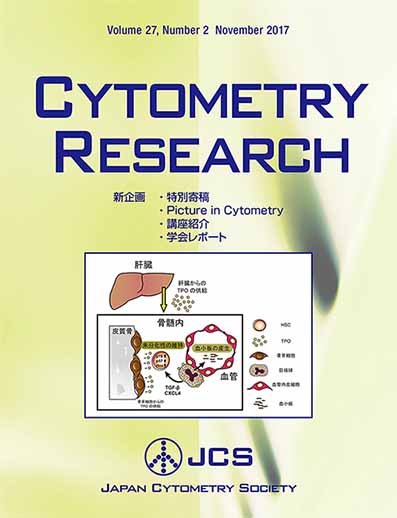Volume 27, Issue 2
Displaying 1-13 of 13 articles from this issue
- |<
- <
- 1
- >
- >|
original paper
-
2017Volume 27Issue 2 Pages 1-7
Published: November 25, 2017
Released on J-STAGE: November 25, 2017
Download PDF (1538K) -
2017Volume 27Issue 2 Pages 9-15
Published: November 25, 2017
Released on J-STAGE: November 25, 2017
Download PDF (3277K)
review
-
2017Volume 27Issue 2 Pages 17-23
Published: November 25, 2017
Released on J-STAGE: November 25, 2017
Download PDF (4675K) -
2017Volume 27Issue 2 Pages 25-29
Published: November 25, 2017
Released on J-STAGE: November 25, 2017
Download PDF (1093K) -
2017Volume 27Issue 2 Pages 31-37
Published: November 25, 2017
Released on J-STAGE: November 25, 2017
Download PDF (1944K) -
2017Volume 27Issue 2 Pages 39-44
Published: November 25, 2017
Released on J-STAGE: November 25, 2017
Download PDF (3936K) -
2017Volume 27Issue 2 Pages 45-50
Published: November 25, 2017
Released on J-STAGE: November 25, 2017
Download PDF (1519K) -
2017Volume 27Issue 2 Pages 51-56
Published: November 25, 2017
Released on J-STAGE: November 25, 2017
Download PDF (1049K)
special articles
-
2017Volume 27Issue 2 Pages 57-59
Published: November 25, 2017
Released on J-STAGE: November 25, 2017
Download PDF (661K)
picture in cytometory
-
2017Volume 27Issue 2 Pages 61-62
Published: November 25, 2017
Released on J-STAGE: November 25, 2017
Download PDF (860K)
introduction of department (basic medicine/research)
-
2017Volume 27Issue 2 Pages 63-64
Published: November 25, 2017
Released on J-STAGE: November 25, 2017
Download PDF (2603K)
introduction of department (clinical medicine)
-
2017Volume 27Issue 2 Pages 65-66
Published: November 25, 2017
Released on J-STAGE: November 25, 2017
Download PDF (1712K)
meeting report
-
2017Volume 27Issue 2 Pages 67-70
Published: November 25, 2017
Released on J-STAGE: November 25, 2017
Download PDF (2967K)
- |<
- <
- 1
- >
- >|
